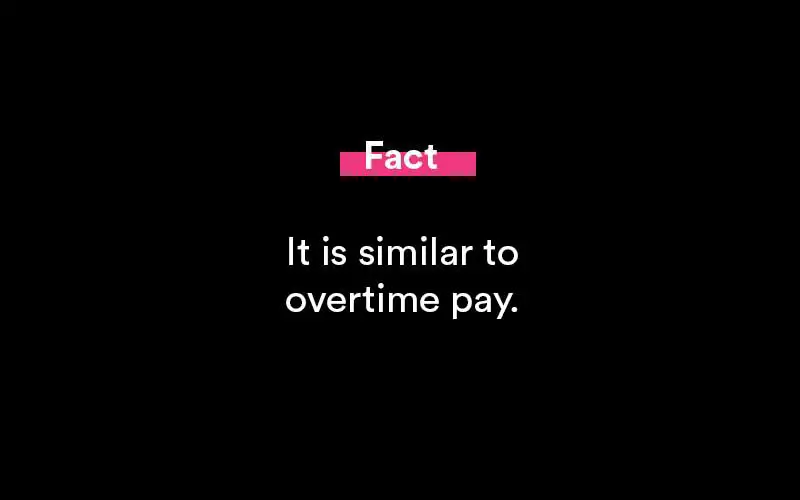How to Calculate Time and a Half (2022 Guide)
What is time and a half? Payroll calculation in large corporations necessitates a variety of formulae. If you work in human resources and need to figure out an employee's compensation, consider holidays, job duties, perks, hours, how much time off they took during that pay period, and what deductions they are eligible for.

Another issue to consider is if they worked any overtime hours, in which case knowing how to compute time and a half is critical.
What is the definition of time and a half?
Non-exempt employees get paid time and a half when they work additional hours outside of the standard 40-hour workweek. This is also known as overtime and gets compensated at a higher rate.
While overtime pay varies by organization, the term "time and a half" refers to a standard arrangement where employers pay employees 1.5 times their hourly compensation for each additional hour they work.
Time and a half is effectively a 50 percent raise above the employee's regular hourly wage. Companies that provide time and a half must pay the employee's regular rate plus a half for each additional hour worked outside of their standard 40-hour week.
This method means that businesses pay more for extra labor, but rewards employees for their dedication and strenuous effort.

What is the formula for calculating time and a half?
Multiply an employee's usual hourly pay rate by 1.5 to compute time and a half. The formula for determining time and a half is as follows:
1.5 times the usual hourly wage = time and a half.
The hourly compensation rate for non-exempt employees who work more than 40 hours per week is calculated using this calculation. When calculating payroll, it's vital to understand that hourly and salaried employees have different computing time and a half systems.
Time and a half get calculated for hourly employees.
You may compute time and a half for hourly employees by following these steps:
Calculate the employee's standard hourly rate.
Multiply the regular hourly rate by 1.5 to get the time and a half rate.
To calculate the overtime earnings due, multiply the time and a half rate by the number of overtime hours the employee worked.
Add the employee's ordinary earnings with overtime wages to arrive at the employee's total wages for that pay period.
Time and a half calculation for salaried staff.
You may compute time and a half for non-exempt salaried employees who work a defined number of hours by following these steps:
Divide the employee's weekly compensation by the number of hours they regularly work to arrive at their standard hourly pay rate.
Multiply the regular hourly rate by 1.5 to get the time and a half rate.
To calculate the overtime earnings due, multiply the time and a half rate by the number of overtime hours the employee worked.
Add up the employee's ordinary earnings (for a two-week pay period, double the weekly income) plus overtime wages to get the employee's total wages for that pay period.
What Does Time and a Half Mean? How to Calculate It and What It Means

Examples of time and a half calculations.
You may compute time and a half for an employee using the calculation and procedures above. Here are two instances of time and a half amounts:
As an example, consider an hourly employee.
Let's imagine you have a $15-per-hour non-exempt hourly employee named Jane at your firm. Susan earns $600 a week working a regular 40-hour workweek. Susan gets paid time and a half when she works more than 40 hours. She worked a total of 50 hours this week, including 10 hours of overtime. Here's how to figure out Jane's time and a half pay rate using the calculation above:
$15 x 1.5 = $22.50
As a result, Susan's overtime pay rate is $22.50 per overtime hour. Multiply Susan's time and a half rate by the number of hours she worked overtime to find out how much she owes for her overtime:
$225 x 10 hours = $22.50
Susan is entitled $225 in addition to her regular pay this week since she worked 10 hours extra. You may figure Susan's total weekly earnings by adding her overtime pay ($225) to her regular weekly pay ($600), for a total of $825.
Example of a salaried employee.
Susan would earn $31,200 per year as a paid employee earning the same hourly rate ($15 per hour). Because her yearly income is less than $35,568, she gets classified as a non-exempt employee under the Fair Labor Standards Act (FLSA). Only non-exempt paid employees are usually entitled to overtime compensation.
Assume Susan, who generally works 40 hours per week, worked 55 hours this week to assist her team in completing a critical project. Susan worked 15 hours of overtime this week, according to this calculation. To find Susan's weekly pay rate, divide her yearly compensation by the total number of weeks in the year:
$600 / 52 = $31,200
Susan's standard hourly pay rate may be calculated by taking her weekly pay rate of $600 and dividing it by 40:
$600 / 40 = $15
Once you know Susan's regular hourly pay rate, you can calculate her time and a half pay rate using the calculation below:

$15 x 1.5 = $22.50
Susan gets paid $22.50 each overtime hour at time and a half. To figure out how much Susan owes for her overtime, multiply her hourly rate by the number of hours she worked overtime:
$22.50 x 15 hours = $337.50
Susan is entitled $337.50 in addition to her regular pay this week since she worked 15 hours extra. You may now compute Susan's total weekly pay by adding her overtime wages ($337.50) to her regular weekly salary ($600), for a total of $937.50.
Other typical overtime pay rates.
Companies must pay a minimum overtime rate of one and a half their regular hourly rate under the FLSA. This implies that the minimum amount that employers must pay workers who work overtime is time and a half.
Some employers prefer to pay their employees more than the legal minimum wage.
Another popular overtime rate is double time. You may compute double time by doubling or multiplying an employee's usual hourly rate by two. This can assist in motivating extra effort even more.
Other businesses prefer tracking overtime at a lower hourly rate than 40 hours per week.
If an employee's usual work schedule is only 37 hours per week, for example, their employer can treat all additional work hours above 37 as overtime, not simply those exceeding 40.
Holiday pay is another popular overtime rate. When employees work on federal holidays, this happens.
The FSLA does not compel employers to provide paid or unpaid time off for federal holidays, nor requires employers to pay extra to workers who work on national holidays.
Despite this, it is customary for businesses to give holiday compensation often more than an employee's regular hourly wage. The amount of holiday pay premium paid is entirely up to the employer.
When is it necessary for businesses to provide time and a half?
According to federal and state legislation, the Fair Labor Standards Act covers all non-exempt employees in the United States.
This means that anyone working more than 40 hours per week is entitled to at least one and a half times their regular hourly wage.
A corporation is liable for paying overtime payments to an employee who is required or permitted to work more than their regular weekly hours.
Some jurisdictions, such as California, have adopted daily overtime rules to guarantee that non-exempt employees get appropriately reimbursed for work that continues beyond the usual eight-hour workday.
As a result of this regulation, any employee who works more than eight hours per day, even if they only work 40 hours per week, is entitled to time and a half pay.
Individuals such as firemen, police officers, other public-sector employees, and those who work for hospitals or nursing homes are exempt from overtime.
Furthermore, companies are not required to pay overtime for labor done on weekends or at night unless the hours exceed the usual 40-hour workweek.
Because there are numerous variances, exceptions, and differences in payroll rules across the country, it is critical to comprehend all national and state regulations completely.
What is time and a half for $15 an hour?
Additional hours worked after an eligible employee has worked 40 hours a week must be paid at a minimum overtime rate of time and a half, which is 1.5 times the usual hourly salary.
If Erin is paid $15 per hour on average, she will be paid $22.50 per hour with time and a half ($15 1.5).
What is time and a half for $17 an hour?
You can take your hourly income and multiply it by 1.5. For $17 per hour, time and a half will equal $25.50 per hour.
What is time and a half for $30 an hour?
Time and a half compensation would be $20 multiplied by 1.5 to equal $30 per hour.
What is time and a half for $25 an hour?
Overtime pay is usually 1.5 times the employee's regular hourly income. "Time-and-a-half" is another name for this number.
So, if a worker earns $15 per hour, their overtime rate is $22.50 ($15 x 1.5).
If another employee gets paid $25 per hour, overtime is $37.50 per hour ($25 x 1.5).
How do I calculate time and a half?
Try this free online calculator for a nonexempt hourly employee and salaried employee.
Popular Resources

Featured
35+ Phone Interview Questions & Best Sample Answers
Phone interviews have become a core part of the process when attempting to find a secured placement for an open position. Companies receive massive responses from potential candidates for any..

Featured
12+ Best Questions To Ask A Recruiter
Concerning a job search, you might receive numerous offers from your recruiters. Before you choose one, you need to assess all the conditions, for which it is vital that you know everything associated with the offered position..

Featured
Answering "What Makes You Unique" In A Job Interview
Answering this question during a job interview requires more than knowing why you are unique as an individual. Yes, the true scientific answer is made up of two main components: your..

Featured
250+ Ice Breaker Questions for Life
An ice breaker question is a question that’s asked from one person to another person in order to act as a conversation starter. It brings a connection...

Featured
10 Best Answers to "What Motivates You?"
Open-ended questions like “What motivates you?” can elicit a deer-in-the-headlights reaction from job candidates if they are unprepared. It’s a broad question and can leave the interviewer..

Featured
Answering "How Did You Hear About This Position" In An Interview
A lot of interviewers ask this question - how did you hear about this position? This way they can judge you if you are a passive or an active job seeker..

Featured
8 Best Thank You Emails After an Interview (Samples, Free Templates)
Writing a thank you note after an interview says a lot about you as a potential employee. Most notably, it says that you care about the opportunities presented..

Featured
Writing a Resignation Letter (How To Write It, Samples)
Writing the perfect letter of resignation is more of an art than it is a science. And we’re going to cover how to master that art form in this full guide..

Featured
How to End a Letter (Example Salutations, Sign Off's)
Knowing how to end a business note or email is an important skill to develop. It helps portray a sense of confidence, respect and tone to your message..
